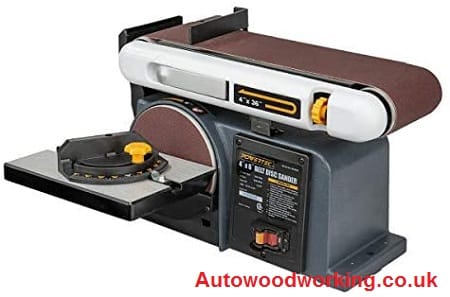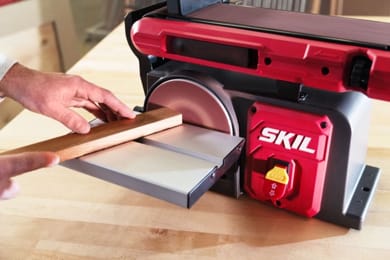As an Amazon Associate, I earn from qualifying purchases.

A belt and disc sander is a versatile and useful power tool that can be used in a variety of woodworking and metalworking projects. If you’re a beginner who wants to learn how to use a belt and disc sander, this comprehensive guide will provide you with the essential tips and techniques you need to get started.
What is a Belt and Disc Sander?
A belt and disc sander is a power tool that combines a belt sander and a disc sander into one machine. The belt sander is used for removing material quickly, while the disc sander is used for fine sanding and smoothing surfaces. These sanders are versatile and can be used for a variety of tasks, such as sanding wood, metal, and plastics.
Different Types of Belt and Disc Sanders
There are different types of belt and disc sanders available in the market, each designed for specific applications. The most common types include:
- Stationary belt and disc sanders: These are large, heavy-duty machines that are designed for professional use. They are fixed to a workbench and can be used for heavy sanding tasks.
- Benchtop belt and disc sanders: These are smaller and more affordable machines that can be easily placed on a workbench or table. They are ideal for DIY enthusiasts and hobbyists.
- Handheld belt sanders: These are portable machines that are held by hand and can be used for sanding hard-to-reach areas.
Choosing the Right Belt and Disc Sander
Choosing the right belt and disc sander depends on the type of project you are working on. Here are some factors to consider:
- Size: Choose a machine that is appropriate for the size of your project.
- Motor power: Look for a machine with a powerful motor to ensure efficient sanding.
- Belt and disc size: Consider the size of the sanding belt and disc, as this will affect the speed and efficiency of the machine.
- Dust collection: Look for a machine with a dust collection system to keep your work area clean.
Preparing to Use a Belt and Disc Sander
Before using a belt and disc sander, it’s important to prepare your work area and the machine. Here are some steps to follow:
- Choose a well-ventilated area with good lighting.
- Make sure the machine is properly grounded.
- Install the sanding belt and disc according to the manufacturer’s instructions.
- Check the tension of the sanding belt and adjust it if necessary.
- Turn on the dust collection system and connect it to a dust extractor or vacuum.
Safety Precautions
When using a belt and disc sander, safety should always be your top priority. Here are some safety precautions to follow:
- Wear safety glasses to protect your eyes from flying debris.
- Wear a dust mask or respirator to avoid inhaling dust.
- Avoid wearing loose clothing or jewelry that can get caught in the machine.
- Keep your fingers and hands away from the sanding belt and disc.
- Never apply too much pressure to the machine, as this can cause the material to kick back.
- Always turn off the machine and unplug it before making any adjustments or changing the sanding belt or disc.
Contents
How to Use a Belt and Disc Sander

Now that you have prepared your work area and the machine, it’s time to start using the belt and disc sander. Here are the steps to follow:
Adjusting the Table
- Adjust the table to the desired angle using the adjustment knobs.
- Make sure the table is level with the sanding belt and disc.
Adjusting the Belt Tension
- Turn on the machine and run the sanding belt for a few seconds.
- Adjust the tension of the sanding belt using the tension adjustment knob.
- Make sure the sanding belt is tracking in the center of the rollers.
Using the Belt Sander
- Hold the material firmly with both hands and apply it to the sanding belt.
- Move the material in the direction of the sanding belt rotation.
- Keep the material moving at a steady pace to avoid creating uneven spots.
Using the Disc Sander

- Hold the material firmly with both hands and apply it to the disc.
- Move the material in a circular motion against the rotation of the disc.
- Keep the material moving at a steady pace to avoid creating uneven spots.
- Avoid applying too much pressure to the disc, as this can cause the material to kick back.
Maintenance and Cleaning Tips
To keep your belt and disc sander in good working condition, it’s important to maintain and clean it regularly. Here are some tips to follow:
- Clean the machine after each use using a soft cloth or brush.
- Inspect the sanding belt and disc for signs of wear and replace them if necessary.
- Lubricate the machine regularly using a recommended lubricant.
- Store the machine in a dry and clean place when not in use.
FAQs
What materials can be sanded using a belt and disc sander?
A: Belt and disc sanders can be used to sand a variety of materials, including wood, metal, and plastics.
How often should I replace the sanding belt and disc?
A: It depends on the frequency and intensity of use. Check the sanding belt and disc regularly for signs of wear, and replace them if necessary.
Can a belt and disc sander be used for curved surfaces?
A: Yes, a belt and disc sander can be used for curved surfaces, but it requires some skill and practice.
Is it necessary to wear a dust mask when using a belt and disc sander?
A: Yes, it’s important to wear a dust mask or respirator to avoid inhaling dust.
How do I maintain my belt and disc sander?
A: Clean the machine after each use, inspect the sanding belt and disc for signs of wear, lubricate the machine regularly, and store it in a dry and clean place when not in use.
Conclusion
A belt and disc sander is a useful tool for woodworking and metalworking projects. However, it can be dangerous if not used correctly. By following the steps and safety precautions outlined in this article, you can use a belt and disc sander safely and efficiently.



